Tactical Headgear for Operational Requirements (THOR) has been adopted by the Finnish Defense Forces as the helmet component of their Soldier Modernization Program: Warrior 2020. A multi-year contract was recently let by the Finnish Defense Forces Logistics Command, with initial deliveries being used for acceptance testing. Savox is the prime contractor of the consortium behind THOR, along with industry partners, Millog Oy (night vision) and Fy-Composites Oy (ballistic protection).
The core of THOR is a boltless design ballistic helmet made from a Dyneema/Aramid blend providing protection against ballistic threats: fragments and bullets to STANAG 2920 1.1g FSP-v50: 450. 750m/s – back face deformation <25mm; NIJ0106.01 9 mm FMJ bullet 430m/s. The shell also meets EN 397 shock absorption requirements.
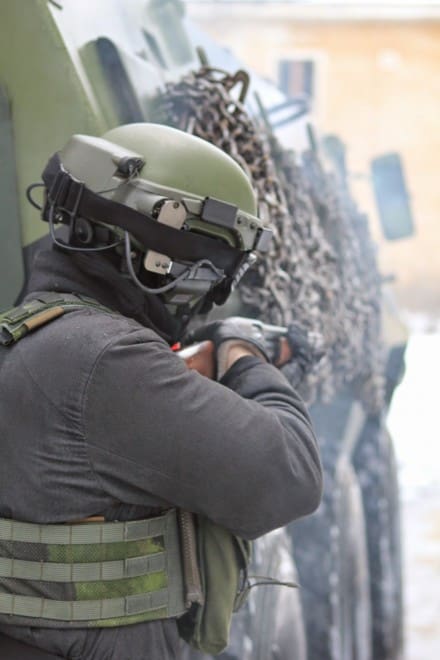
Additionally, special night vision goggles and hearing protection have been designed specifically to integrate with this helmet. As you can see in the photos, the NVGs stow very close to the helmet and are light enough to not need a counterweight. The goggles offer a 60°-wide view angle (also available is 40° FOV) and can be used in mono or bino configurations. These us Millog’s Hi60 3rd Gen tubes offering human recognition up to 150-250m as well as an integrated IR illuminator.
The various technologies developed specifically for the helmet are marketed under FLEXfamily.
For example, the FLEXfit ratchet system allows the rapid adjustment of fit for a wide variety of head types. Next comes FLEXadjust which covers the adjustable, multi-axis mounting systems for the NVGs and earpro. In addition to ANR headphones (23dB), the user can attach a boom or bone conductive skull microphone in addition to throat and internal respirator mic options. Like most systems currently fielded, power and volume adjustments are on the side via buttons. Additionally, the earphones can be placed in one of three positions without removing the helmet or losing communications.
FLEXnet is an integrated databus both internal and external to the helmet. This works hand-in-hand with the FLEXrail which allows the mounting of Picatinny compatible accessories to the powered rail system incorporating a USB integration interface. THOR features five of these FLEXrails which can bring data into the from cameras and sensors helmet as well as exfil it to other devices such as radios. These FLEXrails also incorporate FLEXpower which provides power to the devices as well as all accessories internally through the helmet.
Tags: Finland, Fy-Composites Oy, Millog Oy, Savox


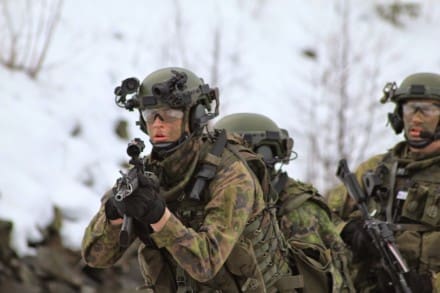
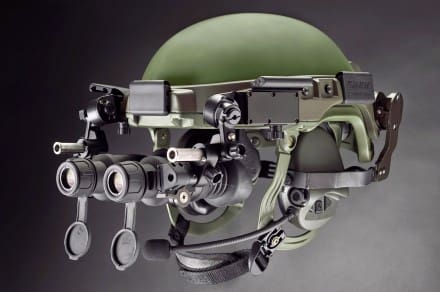
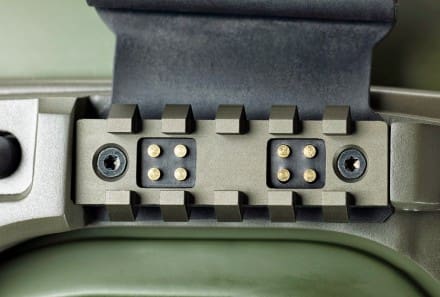
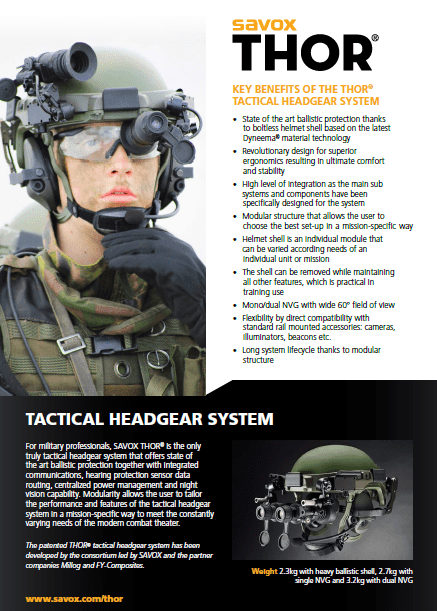
Been seeing this project pop up a lot recently, and has an interested concept behind it. (Particularly the individualized nods and powered rails.) I wonder what the weight difference is between the hardware for each individual nod when compared to the typical coupled set common today.
I also question the powered rails contact pins design and if that would send current through standard mounted accessories in a negative way that aren’t built for the system specifically.
If you look at the power pins on the rails, they sit on a surface that is recessed from the standard rail face. So it’s likely that accessories designed for this system will have a geometry that sits down into this recessed area, and existing accessories will simply not come in contact with the power pins.
They also might have a blanking piece to covers these pins when not in use, to protect them from environmental debris as well.
They do have a cover, its the big black flap piece with SAVOX on it. The system looks like they slap some fancy power adapters for some MUM/PVS and Sordins on MICH.
But it does look good and its modular…
The cover is shown in all four images of the helmet.
Looks lightweight
The Norwegians have a similar looking/functioning NVG mount system (non powered,etc) that they are not happy with. The individual arms that hold the tube tend to wobble/shake after they have been used for awhile. Not saying THOR has this issue but seeing how the design is similar, my concern would be that I would expect to see some of the same issues after prolonged use in the field.
‘m sorry guy’s, but can you explain what is meant by “Bolt-less design…”?
I see quite a few screws on the helmet…
Also, can the rails, since they supply power, be changed out? It would seem to me, constant on/off of rail powered items would, over time, wear the contacts down,,so would this mean the helmets are just DX’d, or are the rail(s) & power contacts themselves replaceable?
Just an observation/my take, but it seems people currently are adding an awful lot of shit-sometimes heavy shit (as the “Light Infantry jokes go, “lightweight” is relative) on to Helmets.
As a Medic,I wonder
(A): If there is a better way.
(B): How long this trend will last until common sense or “A”,above takes over.
Headaches at the worst, TMP and spinal disc problems at the worst seem like the are-a-coming, just like back and leg issues for Paratroopers.
I won’t even start on how much crap some troopers see necessary to hang off their rifles & carbines…
PS: I honestly don’t know what “Bolt-less Design” means-I’m not being a smart-ass. Upon reading, that’s how it seemed to come across,and i am sorry.
My understanding is that the ballistic shell has no bolts going through it for things like NVG shrouds & harness systems.
Yes, that’s what boltless means. There are also no bolts going through the helmet for a suspension.
As another medic, I too have looked on with distaste as more and more things get strapped to the helmet. My big concern isn’t as much the carrying it around on your head day to day (although that is bad too) as much as what happens to your neck in a high-G incident with the extra weight on your noggin. Think about a fall, vehicle roll over or helo crash with those extra pounds/kilos pulling on your head.
It just seems like every time a materials advancement brings the weight of the helmet down…we strap more stuff to it to bring it back up.
The amount of people who actually use dual tube NVGs is so laughably tiny and insignificant compared to those that use nothing, or use conventional monoculars that when people talk about developing solutions like this, you have to realize it only applies to a few hundred units, possibly a few thousand if it’s for the US military.
Maybe in the last 10 years, but is more and more common everyday. NVGs price is dropping fast, and like PEQs will be an issued item for most Infantry units in the next years.
Those few hundred/thousand will use more advanced systems, like thermal/I2 fusion and such.
Torilla tavataan!
But in all seriousness, I am looking forward to any news I see and hear about Taistelija 2020 (Combatant 2020), the Finnish future soldier program. But warrior would be “soturi,” which has a different connotation, even though korpisoturi (woodswarrior) is still part of military slang to this day.
We’ll see if I get to wear this at some point, whether it be during refresher training or war. I’m hoping Kypärä 2020 is a lot more comfortable than the m/92. During my conscript period, my issued one’s strap broke right after a field exercise.
One thing should be of note: rear-line troops can wear the helmet basically stripped of all electronic toys and use it like any ballistic helmet.
Would be great to see if we can export this.